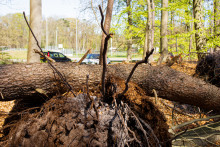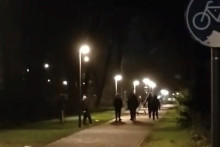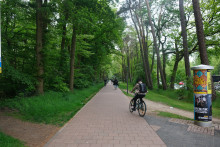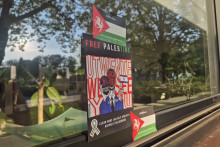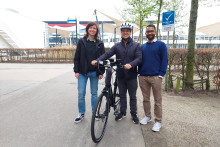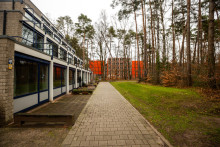It’s a warm spring day, t-shirt weather. Naturally, in these circumstances, birds are singing and the trees are in bright green spring leaf. One or two white butterflies flutter at the side of the road. It’s just the day for a pleasant walk.
Geert de Haan and Richard Kirschbaum are from landscape company Krinkels, that closely collaborates with the UT’s Campus & Facility Management department to manage the campus. Kirschbaum is an ecologist, while De Haan is foreman. Today they have agreed to take us on a walk around campus and introduce some of its often secret yet vigorous wildlife, and how their company, in combination with the UT, is working to make the campus more sustainable.
Natural bee hotel
The first stop of the day is in the patch of trees across the road from the Box, the student housing complex. An old dead tree lies on the ground, half sunken in dead leaves, its twisted roots exposed to the air. Kirschbaum leads the way to it. ‘We try to leave as much dead wood as possible’, he says. ‘Because beetles and other insects make their homes in it and leave little tunnels that bees lay their eggs in.’ He looks around, then points to a dead tree that is still upright, most of its bark missing and wood bleached white. ‘Standing dead wood attracts different species than laying dead wood. So it’s important to have dead standing and dead laying trees’. It’s the ‘natural version of a bee hotel’, Kirschbaum says.
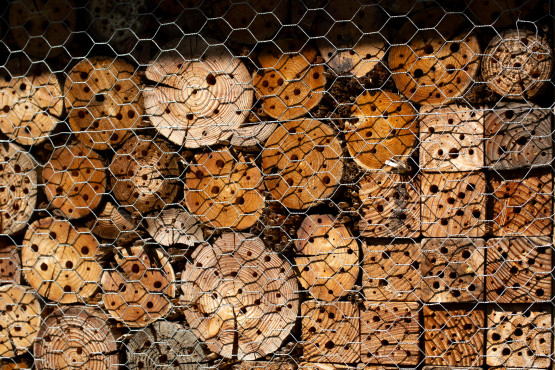
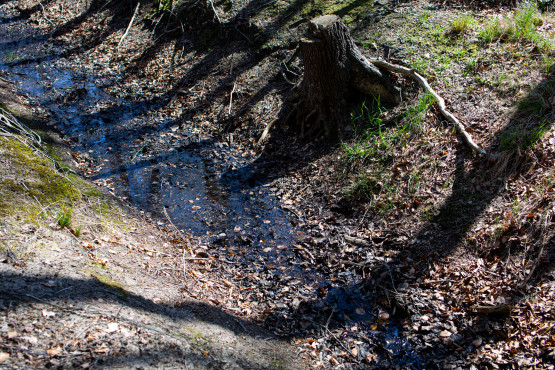
On the edge of the little woodland is a muddy ditch, filled with dead leaves and shallow water. It doesn’t look like much, but Kirshbaum explains that ‘amphibians sleep in the mud in the winter. So it’s important not to dig here.’ This is actually a main issue when it comes to people’s view of a ‘green campus’, the two of them explain. ‘Most people see this stuff and think it’s ugly and has no biodiversity. In fact, as a case in point, 80 percent of bees in the Netherlands lay their eggs in sand, so bee hotels don’t help most bees. We like to see those around us, but they only help 20 percent of the bee population. Most things are happening in the ground.’
Symbiosis
Leaving the woods behind, the walk continues towards the pool behind Mondriaan, another student housing complex at the edge of campus, passing the baseball field and Vlinder. On the way to the water, the discussion continues. ‘Of course, the campus is not a nature reserve, but we can still create high biodiversity’.
De Haan mentions that it’s important to create ‘symbiosis’ on campus. A prime example is the oak processionary caterpillar, that the UT and Krinkels have to battle every year in springtime. ‘We do this by stimulating the natural enemies of the caterpillars. They are a pretty new plague, so we still need to sometimes suck them away. But we mostly use nematodes we can spray. They are a natural enemy that go inside the caterpillar and lay eggs. These eggs then hatch and the young eat the caterpillar from the inside out. Another natural enemy of the caterpillars is great tit (koolmees in Dutch, ed.), a small bird which the little white bird houses in several of the trees on campus are there to attract.’
Nearing Mondriaan, a few ragged planted flowers grow at the edge of the road. Beyond the flowers lies some scrubby grass, scattered with a few small trees before another little forest starts. Kirschbaum explains that eco-friendly grass actually needs to be maintained. ‘If you don’t mow grass, a forest will grow there. Ecological grassland should be mown about twice a year’. In earlier times large grazing animals would fill that function, now it’s up to people and machines.
Water management
The pond behind Mondriaan is large, the water dark and dotted with waterlilies. Small scrubby trees grow along the edges of the banks, interspersed with various waterweeds. Kirschbaum picks a leaf from one dark-leaved plant and rubs it between his fingers, releasing a pungent scent. Water mint.
This is a ‘special lake’, because it is home to ‘endangered dragonflies’, he explains. ‘They are currently nymphs in the water. When they climb out of the water and metamorphose, they will fly for about six weeks and lay eggs on the vegetation. So we ensure that we don’t mow all the vegetation in the water. Only about 30 percent.’
The pond is also home to another species of dragonfly ‘who fly only once in three years’, adds Kirschbaum. ‘This pond, like many things on campus, also serves a purpose to collect rainwater. If it doesn’t go into drainage on campus, it goes here.’
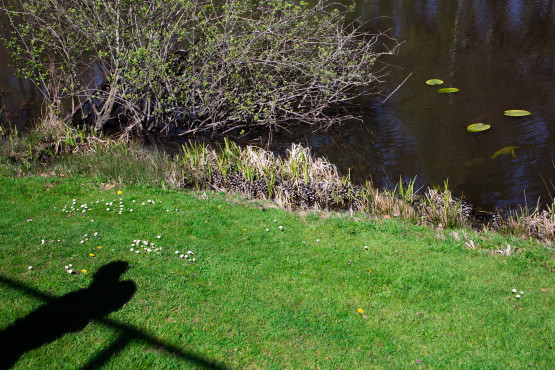
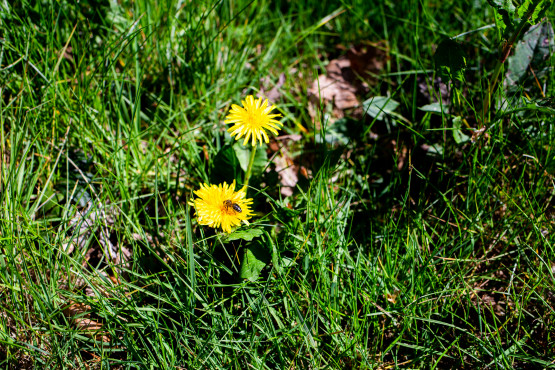
‘Trees are CO2 neutral at the age of 33 years’
The way back from the pool leads past a little stream, the opposite bank thick and knotted with tree roots. Tall beech trees stretch into the sky, smaller younger trees at their feet. Kirschbaum gestures to the new growth. ‘In seven years this all came back from broken dead trees’, since ‘beech trees are all dying from the top down.’
To replace the old monoculture of beech, there are ‘plans to plant new trees, local species that are naturally here, with seeds chosen to attract the natural enemies of the oak processionary caterpillar.’
On the topic of trees, De Haan brings up the large adult trees that were recently replanted near the Horst building. They were ’40 tonne trees, planted with a crane’. They were moved out of the way for construction of the new workplace for the ET faculty. ‘The municipality wanted them cut down, but the university moved them. Trees are CO2 neutral at the age of 33 years, so this was very much worth it’. In addition, they add that, since large trees are often habitats for bats, before ‘removing a tree where there might be a bat nest, we build two new bat boxes and remove the tree only when the bat has moved.’
As the walk winds to an end, the conversation turns to the future. Krinkels has been contracted to manage campus grounds for the next ten years. Together with the UT’s Campus & Facility department, they have plans to improve ‘biodiversity in all areas’. ‘Even when it comes to new buildings, we want to include ecology and nature at construction.’

The trees at the Horst being replanted earlier this year.


